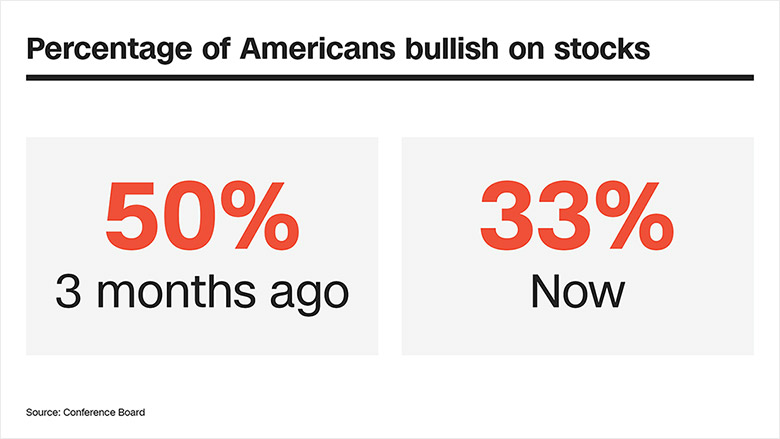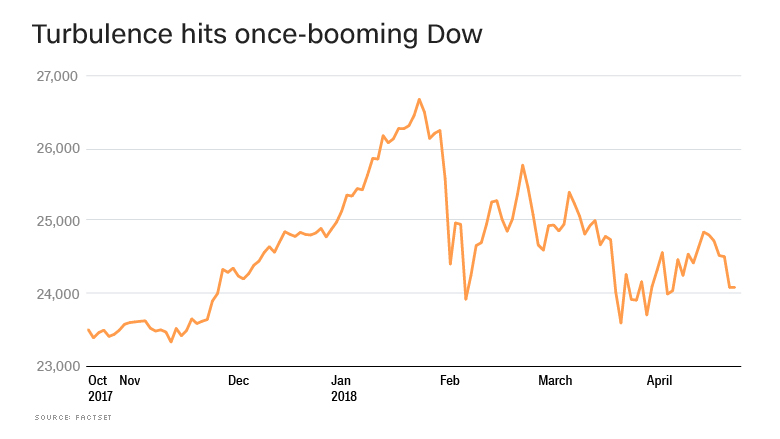
Main Street’s confidence in the stock market is crumbling at the fastest pace since at least 1987.
Americans remain optimistic about the economy, but their attitude toward stocks has gone from euphoric to negative as turbulence has rocked Wall Street.
Just 33% of people polled by the Conference Board this month expected stock prices to rise over the next year.
That’s down dramatically from a record high of 51% who were bullish in January, back when the Dow was zooming beyond 26,000.
Since the market peaked in late January, though, fears about inflation and trade wars have driven the Dow down more than 2,500 points. Stocks tumbled again this week because of concerns about the resiliency of corporate earnings and soaring bond yields.
The sudden shift in confidence in the market is the fastest swing since the Conference Board began keeping track in 1987, according to Bespoke Investment Group.
“Investors were way too confident — they seemed to see only the positive aspects of the Trump administration’s agenda,” said Kristina Hooper, global market strategist at Invesco. “This is a case of Icarus flying too close to the sun.”
More recently, President Trump’s aggressive use of tariffs and attacks on Amazon (AMZN) have rattled an already wobbly Wall Street.
“Investors’ eyes seem to finally be wide open,” Hooper said.

Just 20% of Americans polled by the Conference Board, a business research association, were negative on the stock market in January. Now one-third are bearish. April was also the first month since President Trump’s election when more people were negative than positive on stocks.
“At the end of last year, we were in this feel-good area. Nothing could knock the market off its perch,” said JJ Kinahan, chief market strategist at Ameritrade. “Now that there is risk back in the market, people are more suspicious.”
The S&P 500 has moved up or down at least 1% on 30 trading days in 2018. Compare that with 2017, when it only happened eight times all year.
TD Ameritrade’s own research shows that everyday investors have rapidly soured on the market. The company’s Investor Movement Index, which measures investor activity, has declined every month this year after hitting a record high in late 2017.
One factor that Kinahan said could be at play: Investors may be overreacting to point drops on the Dow that sound scarier than they really are. The Dow is so high that even a 100-point decline represents a loss of less than half a percent.
“Ten years ago, 500 points was ‘hide the women and children.’ Now, it’s 2%,” Kinahan said.
Even professionals have become more cautious, though. Fifty-eight percent of global money mangers surveyed by Bank of America Merrill Lynch think the stock market has already peaked or will peak later this year.

Regardless of the driver, is the loss of confidence in stocks an ominous sign for the nine-year-old bull market?
Maybe not. The whims of average investors don’t typically signal doom for the market. In fact, the opposite is often true: They are bullish when they should be cautious, and vice versa.
When confidence in the market drops sharply over three months, the S&P 500 goes up an average of 22% over the next year, Bespoke Investment Group found.
The most recent example was in 2011, during the debt ceiling showdown and downgrade of America’s AAA credit rating.
The S&P 500 dropped 7% in September 2011. But it quickly stabilized, and a year later, it was up a solid 15%. Likewise, one year after a collapse in confidence in the spring of 1997, the S&P 500 had surged 39%.
Negative consumer sentiment on stocks, according to Bespoke, is a “pretty reliable contrarian signal over time.”
























